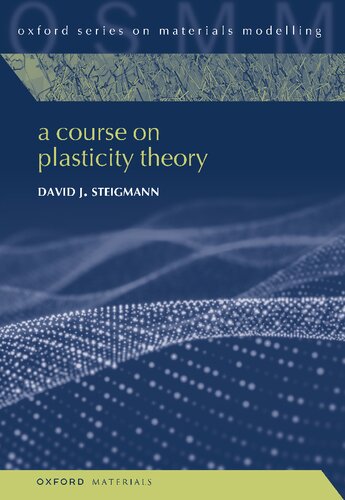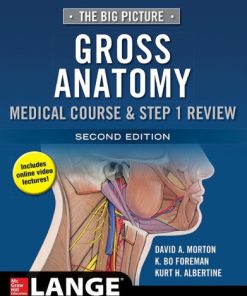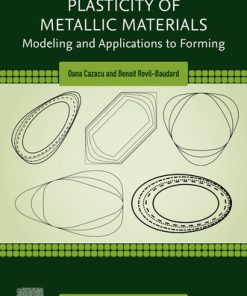(EBOOK PDF)A Course on Plasticity Theory 1st edition by David Steigmann 9780192884152 0192884158 full chapters
$50.00 Original price was: $50.00.$25.00Current price is: $25.00.
A Course on Plasticity Theory 1st edition by David Steigmann – Ebook PDF Instant Download/Delivery: 9780192884152, 0192884158
Full download A Course on Plasticity Theory 1st edition after payment
Product details:
• ISBN 10:0192884158
• ISBN 13:9780192884152
• Author:David Steigmann
A Course on Plasticity Theory
Plasticity Theory is characterized by many competing and often incompatible points of view. This book seeks to strengthen the foundations of continuum plasticity theory, emphasizing a unifying perspective grounded in the fundamental notion of material symmetry. Steigmann’s book offers a systematic framework for the proper understanding of established models of plasticity and for their modern extensions and generalizations. Particular emphasis is placed on the differential-geometric aspects of the subject and their role in illuminating the conceptual foundations of plasticity theory. Classical models, together with several subjects of interest in contemporary research, are developed in a unified format. The book is addressed to graduate students and academics working in the field of continuum mechanics.
A Course on Plasticity Theory 1st Table of contents:
1 Preliminaries
1.1 Phenomenology
1.2 Elements of continuum mechanics
2 Brief resumé of nonlinear elasticity theory
2.1 Stress and strain energy
2.2 Conservative problems and potential energy
2.3 The Legendre–Hadamard inequality
2.4 Material symmetry
3 A primer on tensor analysis in three-dimensional space
3.1 Coordinates, bases, vectors, and metrics
3.2 Second-order tensors
3.3 Derivatives and connections
3.4 The Levi-Civita connection
3.5 The curl, Stokes’ theorem, and curvature
3.6 Torsion and the Weitzenböck connection
4 Deformation and stress in convected coordinates
4.1 Deformation gradient and strain
4.2 Strain compatibility
4.3 Stress, equations of motion
5 Elastic and plastic deformations
5.1 Elastic–plastic deformation, dislocation density
5.2 Differential-geometric considerations
5.3 Incompatibility of the elastic strain
6 Energy, stress, dissipation, and plastic evolution
6.1 Materially uniform elastic bodies
6.2 Surface dislocations and stress relaxation
6.3 Dissipation due to plastic evolution
6.4 Superposed rigid-body motions
6.5 Yielding and plastic flow
6.6 Crystallinity versus isotropy
6.7 Discontinuous fields
7 Isotropy
7.1 The flow rule
7.2 Von Mises’ yield function
7.3 The classical theory for isotropic rigid-plastic materials
7.4 Bingham’s model of viscoplasticity
7.4.1 Example: Steady channel flow
7.5 Plane strain of rigid-perfectly plastic materials: Slip-line theory
7.5.1 Stress, equilibrium
7.5.2 Velocity field
7.5.3 Cartesian form of the equations
7.5.4 Further theory for plane strain
7.5.5 Axisymmetric state exterior to a traction-free circular hole
7.6 Anti-plane shear
8 Small-deformation theory
8.1 The displacement field
8.2 Approximations for small displacement gradients
8.3 The frame-invariant Prandtl–Reuss theory
9 Strain hardening, rate sensitivity, and gradient plasticity
9.1 “Isotropic” hardening
9.2 Rate sensitivity: Viscoplasticity
9.3 Scale effects
9.3.1 Crystalline symmetry
9.3.2 Isotropy
9.4 Scale-dependent yielding
9.5 Gradient plasticity
9.5.1 Energetic response functions
9.5.2 Stress power, balance laws, and dissipation
9.5.3 Example
Solutions to selected problems
Index
People also search for A Course on Plasticity Theory 1st:
a course on plasticity
a course on plasticity theory
what is a plasticity
what is adaptive plasticity
how does plasticity work
Tags:
A Course,Plasticity Theory,David Steigmann
You may also like…
Religion & Spirituality - Bible
Politics & Philosophy - Government & Politics
Medicine - Nursing
Notes on Caring 1st edition by David Stanley 139421717X 978-1394217175
Uncategorized
Languages - General & Miscellaneous Languages - Reference












